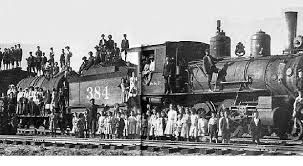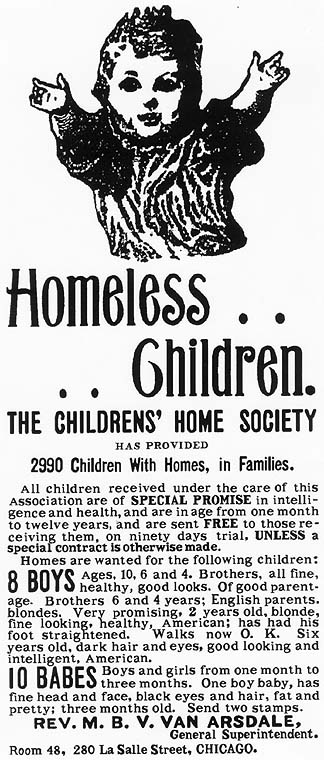Encyclopedia Dubuque
"Encyclopedia Dubuque is the online authority for all things Dubuque, written by the people who know the city best.”
Marshall Cohen—researcher and producer, CNN
Affiliated with the Local History Network of the State Historical Society of Iowa, and the Iowa Museum Association.
ORPHAN TRAINS
ORPHAN TRAINS.
Dubuque Sunday Herald
Dubuque, Iowa
05 September 1886
More Little Ones Coming
Agent Curren, of the New York Foundling and
Orphan Asylum, to Arrive Here with Fifty Children
for People in this Vicinity.
The Herald is in receipt of a letter form Mr. Robert Curren,
agent of the New York Foundling and Orphan Asylum, stating
that he will pass through this city on next Thursday, Sept.
9th, with fifty more little children to be given to families
at Epworth, Farley, Dyersville, New Vienna and Luxemburg and
a few will also be given to families in Fort Dodge. He adds
that fifty more will be brought to Iowa the 1st of October and
will find homes with families between Dubuque and Charles City
on the Milwaukee and St. Paul road. (1)
The Daily Herald reported that:
A carload of boys from the Children's Aid Society, New York, passed
through the city yesterday, in charge of an agent, who is seeking
hoes for them among western farmers. (2)
Dubuque Daily Times
Dubuque, Iowa
Friday Morning, 25 Jun 1888
Handsome Children (3)
Fifty Three Orphan Children Arrive in the City From New York And Are Speedily Taken by Charge by Foster Parents
A scene occurred at the Page House and the vicinity of the Chicago,
Milwaukee & St. Paul depot yesterday morning which will not soon be
forgotten by those who witnessed it.
Attached to Central's train from the east there arrived a carload of
children ranging in age from 2 1/2 to 3 years.
They were from New York Foundlings Home in charge of the Sisters of
Charity. Mr. Curran, the affable agent for the institution, and two
experience nurses, Mrs. E. Higgins and Mrs. M. Connolly, accompanied
the children. The arrival of the little ones attracted an immense
crowd to the Page House. The foster parents of the children were there
in force.
A Happy looking party the children were when they were taken from the
coach. They were all unusually attractive looking, clad as there were
the boys in tidy kilt suits and the little girls in neatly fitting dresses
with white caps. After they were placed upon the depot platform they
followed the attendants into the waiting room of the Milwaukee depot
by couples hand in hand. The crown could scarcely be kept from grabbing
the children and making off with them so eager were the foster parents
to get their chance. "Aren't they cute?" Oh, I want that little fellow
with the long curls" these and similar expressions were heard on all
sides. Mr. Curran however, before leaving New York, had selected parents
for each child, and, on the collar was the name of the child's foster
parents. Mr. Curran informed the crowd that all the children were engaged,
but that he would be here the first week of September next with fifty more.
Those who want to adopt children at that time should apply meanwhile to
the parish priest, a recommendation from whom would secure each of them
a child.
The scene was indeed a pathetic one. A majority of the children took kindly
to their newly found parents, but some of them cried piteously when they were
being taken away. A fashionably dressed lady took a fancy to a bright little
girl with black eyes and hair who had been given to a lady at Kings post-office.
The lady in question offered $50 if she would transfer the child to her. The
former objected and the fashionable lady increased her efforts to $100 without
avail.
Mr. Curran was met by the TIMES reporter. He stated that the institution of
which he is an agent has furnished homes for 8,000 orphan children. The
parting from the sisters at New York he describes as a very pathetic scene,
the little ones knowing no home but the asylum. The children were received
into the institution as foundlings and are nursed at a heavy expense. Of
the fifty three brought to this city yesterday, twenty three are boys, the
remainder girls. Mr. Curran first visits the locality where it is desired
to locate a number of the orphans, and ascertains whether the applicant is
a worthy person. If so, he or she must first furnish a recommendation from
the priest of the parish, and sign and indenture which provides that the
Orphan's Home Association shall take the child, if after one year's trial,
it has not been treated well. If after a fair trial the priest is satisfied
the child has a good home, and indenture is given the foster parents to keep
the child until it becomes of age.
Mr. Curran visits the children in their newly found homes once a year. He
tells many amusing tales of the applicants for children. Most of them
describe the eyes, color of hair, and general character of the child desires,
which he selects in the kindergarten attached to the asylum. The Germans
object to red hair. Yesterday one woman who timidly objected because the
child given to her was auburn-haired quickly withdrew her complaint.
Nevertheless, Mr. Curran would allow her to have no child. A middle aged
man was so pleased that he went up town and bought enough knick knacks, clothes,
etc., to start a good sized country store. But ten of the children found
homes in Dubuque. The depots were thronged last night with the little ones
with their foster parents on their way to their homes.
Between 1858 and 1929 an estimated twenty-five homeless children from the streets of New York or the Children's Village (then known as the New York Juvenile Asylum and later the New York Foundling Hospital}, and the former Orphan Asylum Society of the City of New York (later called the Graham-Windham Home for Children) found a new home in Dubuque. (4) They came by way of the "Orphan Train," a pioneering initiative which led to child welfare reforms, including child labor laws, adoption and the establishment of foster care services, public education, the provision of health care and nutrition and vocational training. (5)
In the 1850s, an estimated 30,000 children known as "street Arabs" were homeless in New York City. (6) Ranging in age from about six to eighteen, they lived on New York City's streets and in slums with little or no hope of a successful future. Charles Loring Brace, the founder of The Children's Aid Society, believed by removing youngsters from the poverty and crime of the city streets and placing them in morally upright farm families they would have a chance of escaping a lifetime of suffering. (7)
Rev. Brace proposed that homeless children could be sent by train to live and work on farms. They would be placed in homes for free, but they would serve as an extra pair of hands to help with chores. They would not be indentured. Older children were to be paid for their labors. (8) In 1853, Rev. Brace founded the Children's Aid Society to arrange the trips, raise the money, and obtain the legal permissions needed for relocation. (9)
Many agencies nationwide placed children on trains to go to foster homes. The orphans were scrubbed, dressed in new clothes and put aboard westbound trains at Grand Central Station. The children were not told where they were going or why. They had no idea that they were on an orphan train or that they had become participants in the largest children’s migration in history. (10)
Orphan trains stopped at more than forty-five states across the country as well as Canada and Mexico. During the early years, Indiana received the largest number of children. (11) From 1854 until 1929 an estimated 250,000 children were placed in new homes. (12) Between 1858 and 1910, a total of 6,675 children found new homes in Iowa. (13) Generally smaller towns were chosen for the children, but cities like Cedar Rapids and Dubuque are believed to each have become the homes of as many as twenty-five. (14)
Over many years, a compiled list of people coming to Dubuque was developed by Madonna Harm. (15) The following lists the orphan's actual name (or * adopted name), date of arrival, and person who took the child.
George J. Augmeier June 13, 1872 James Rea
Frances Bauer(*) John Bauer
Arnold Beckett Chapman
Henry Begley John Plaburne
Mary Broklin Adam Behringer
Rita A. Burnham Schumacher
Rita A. Byrne(*) Schumacher
Alice Crannan Rev. D. J. Slattery
Stella Knights Richard Powers
Moses Joseph Moritz Oscar Enders
Sara Moritz Oscar Enders
George Radford Martin Behyl
Amy Reichert (*) George Reichel
Frank Reigler (*) Reigler
Elizabeth Roche Wichman
Alma Rousseau Anna M. Bartholomew
Laura Seymour Monastery in Dubuque
Thomas Taylor Unknown
Clara Von Nostrand George Banworth, Sr.
George Frank Wichman (*) Wichman
Alice Wilson Anthony Digman
Alice Wilson John Klosterman
Catherine Wilson Elizabeth Ronan
James Paul Wilson Unknown
Placement into new families was casual at best. Handbills announced the arrival of the needy children. As the trains pulled into towns, the youngsters were cleaned up and paraded before crowds of "prospective parents." (16) In later years, "parents" wrote to the New York agencies requesting a certain sex, age, hair and eye color. (17) Some of the children struggled in their new surroundings. Children could live with a family for several months and then be sent back to the orphanage. (18) Others went on to lead normal lives. Although records were not always well kept, some of the children placed in the West went on to great successes. Records indicate that among the relocated children the future found: two governors, one congressman, one sheriff, two district attorneys, three county commissioners as well as numerous bankers, lawyers, physicians, journalists, ministers, teachers and businessmen. (19)
In later years, children who thought the adults they had grown up with were their biological parents often found themselves with nothing after their "parents" had died. Many had no idea where they were born or their original names. Children in the 1800s in New York could be left at a church with no questions being asked. In other instances, a child might have only their first name pinned to their blanket.
Few of the actual orphans who were involved in the train remained alive in 2014. Their descendants, however, could number in the millions. For them the internet has proven a useful tool to find their heritage. Among other sites useful have been The National Orphan Train Complex: http://orphantraindepot.org/ and the Louisiana Orphan Train Museum: http://www.laorphantrain.com/
See: Riders on the Orphan Train
http://youtu.be/kexzcq8cXto
Orphan Train: Largest Child Migration
http://youtube.com/watch?v=G2nqLt5YGls
Orphan Trains
http://youtube.com/watch?v=cWTTcNBfaRw
---
Source:
1. "Orphan Train Riders to Iowa," IaGenWeb Project, Online: http://iagenweb.org/dubuque/orphans/05Sept1886.htm
2. "Caught on the Fly," The Daily Herald, November 23, 1877, p. 4
3. "Orphan Train Riders...
4. Kidder, Clark and Krantz, Colleen Bradford. "West By Orphan Train," Iowa Public Television presentation, December 1, 2014
5. "The Orphan Trains," The Children's Aid Society," Online: http://www.childrensaidsociety.org/about/history/orphan-trains
6. "The Orphan Trains," An American Experience, Online: http://www.pbs.org/wgbh/amex/orphan/
7. Children's Aid Society.
8. Ibid.
9. An American Experience
10. Warren, Andrea. "The Orphan Train," Washingtonpost.com Online: http://www.washingtonpost.com/wp-srv/national/horizon/nov98/orphan.htm
11. Children's Aid Society
12. Moore, Alison. Riders on the Orphan Train. The Official Outreach Program of the National Orphan Train Complex. Online: http://www.ridersontheorphantrain.org/
13. Kidder et al.
14. Ibid.
15. "Orphan Train Riders to Iowa," Cyndi's List. Online: http://www.cyndislist.com/railroads/orphan-trains/
16. An American Experience
17. Kidder, et al.
18. Ibid.
19. Children's Aid Society




